Do you want to start a Preschool business plan?
Are you thinking of drafting a business plan for a preschool? If you want to know how to write a business plan for a preschool, you can refer to business plans like the one presented here.
Starting a new business can be hard, especially in the education sector but it can also be very rewarding. So, if you want to know how to develop a business plan for angel investors that will get them excited and interested in your business, then start by following this document.
Here, we will be presenting a preschool business plan with a focus on tutoring business ideas.
Executive Summary
2.1 What is The Business
This document contains the sample business plan for preschool that will be called LearnALot. LearnALot will be a preschool/ daycare center operated and managed by Theodore Krasinski. It will offer parents a chance to make their kids have fun in a safe environment. Besides, the kids will also be taught the basics.
2.2 Management of Preschool
Starting a preschool business plan can be hard. But the process to plan and manage the business becomes easier if you split it into smaller and more manageable parts. If you want to make a business plan for a preschool center, the first thing you need to do is to draft everything.
In this business plan for a preschool pdf, we will plan out all the necessary details of LearnALot one by one. If you want to write a business plan for preschool, you can follow the guide. You can also hire business planning services to get a professional business plan written for your startup.
2.3 Customers of Preschool
The customers of LearnALot will belong to all kinds of family backgrounds. Due to our daycare services, parents or families with small or special needs children will make a major customer group.
- Working Parents
- Single Parents
- Concerned Parents
- Families with special needs kids
2.4 Business Target
The target of LearnALot is to become a reliable daycare and educational center for the residents in Florida. We aim to cater to healthy and normal children as well as those with special needs.
The financial targets that LearnALot wants to achieve within the first three years of operation are demonstrated below:
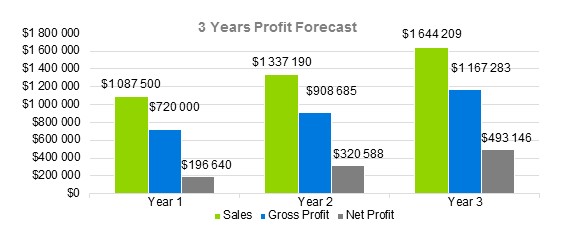
Company Summary
3.1 Company Owner
Theodore Krasinski will be the owner and manager of LearnALot. Theo got his master’s in education three years ago after which he served as a teacher for two years and as a principal in the third year. However, he always felt a need to do more so he decided to open a special preschool himself.
3.2 Company History
Theo noticed that though public schools were trying their best, they didn’t focus on acquiring the tools to cater to children of different needs. There was also a lack of preschools and daycares in the surrounding. To eradicate this issue, Theo decided to open a preschool that would prepare students of all kinds to keep up when they got into school.
3.3 How the Preschool will be started
Step1: Evaluate Goals
Starting up a preschool business or any business in that domain requires a lot more than money. Before you start a business, you need to be sure about the goal you want to achieve via it. The goal can be scaling up the business, earning profits or increasing the well-being of the community, or anything else. But there needs to be a solid goal to direct your operations.
In this open driving school business plan, we will list the SMART business goals adopted by LearnALot.
Step2: Plan the Business
Once you are sure about the goals of your business, you can start developing a business plan template for preschool. If you are not sure how to develop a business plan, you can take help from preschool business plan examples like this one to learn how to write a business plan for a preschool.
Step3: Plan Structure and Logistics
Now that you know the base details of the business, you will be able to sort out the finances. This will include estimating the costs that will be involved in starting the business.
Step4: Get Funding
Any business needs money to start and function before it can become self-sustaining. To get the initial funding for LearnALot, Theo decided to write up a strong business plan that would wow the investors.
Step5: Find a Physical Space
Every business, big or small, needs space to function. Therefore, to start a preschool, you will need a building to set up everything. Theo decided to rent out a building with some space in the front so that he could develop an outdoor play area as well.
Step6: Promote and Market
The final step of the business is to develop a marketing plan to promote the business both in the online and physical realm. Theo will hire a marketing plan specialist to develop a marketing plan that can be easily followed to bring more customers to the business.
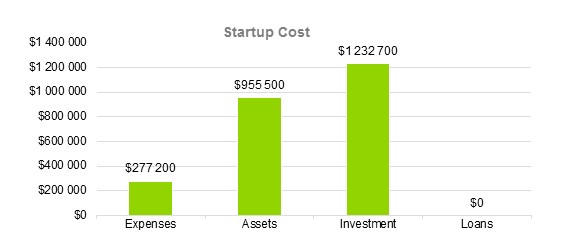
| Start-up Expenses | |
| Legal | $151,400 |
| Consultants | $0 |
| Insurance | $25,100 |
| Rent | $35,100 |
| Research and Development | $10,000 |
| Expensed Equipment | $52,200 |
| Signs | $3,400 |
| TOTAL START-UP EXPENSES | $277,200 |
| Start-up Assets | $251,400 |
| Cash Required | $201,000 |
| Start-up Inventory | $35,100 |
| Other Current Assets | $251,000 |
| Long-term Assets | $217,000 |
| TOTAL ASSETS | $955,500 |
| Total Requirements | $1,232,700 |
| START-UP FUNDING | |
| Start-up Expenses to Fund | $277,200 |
| Start-up Assets to Fund | $955,500 |
| TOTAL FUNDING REQUIRED | $1,232,700 |
| Assets | |
| Non-cash Assets from Start-up | $1,242,000 |
| Cash Requirements from Start-up | $115,000 |
| Additional Cash Raised | $50,000 |
| Cash Balance on Starting Date | $35,000 |
| TOTAL ASSETS | $1,442,000 |
| Liabilities and Capital | |
| Liabilities | $18,200 |
| Current Borrowing | $0 |
| Long-term Liabilities | $0 |
| Accounts Payable (Outstanding Bills) | $51,500 |
| Other Current Liabilities (interest-free) | $0 |
| TOTAL LIABILITIES | $69,700 |
| Capital | |
| Planned Investment | $1,232,700 |
| Investor 1 | $0 |
| Investor 2 | $0 |
| Other | $0 |
| Additional Investment Requirement | $0 |
| TOTAL PLANNED INVESTMENT | $1,232,700 |
| Loss at Start-up (Start-up Expenses) | $139,600 |
| TOTAL CAPITAL | $1,372,300 |
| TOTAL CAPITAL AND LIABILITIES | $1,442,000 |
| Total Funding | $1,232,700 |
Services
All business plans including business plans for preschools include details of what services or products the business will provide. Deciding these things ahead of time allows you to develop a preschool business proposal more efficiently.
A preschool business plan like an e-learning business plan will help you map your business in detail. That will, in turn, allow you to manage it in a better way and gain more funding.
In the case of this preschool business plan template, Theo decided to include all the major services that he will offer to the customers through his business.
- Day Care Services
The primary service provided by LearnALot will be daycare. The business will offer daycare services for all types of parents. This will include parents who just want to drop their kids temporarily for a few hours while they get done with their day-to-day tasks. The other option will be for parents who want to entrust their kids regularly as they are off to work.
- Special Education Services
LearnALot will also cater to families and parents who have special needs children. This can include children who need help with physical activities or children, who, perhaps have a different way and speed of learning.
- Playgroup
As Theo wants to offer a one-place-for-everything business, there will also be some learning activities for the kids to learn as they play. Parents will have the choice of opting their kids out of these activities. However, Theo will try to encourage parents to allow their children, a free environment so they can adjust better when they get into school later.
- Transportation
LearnALot is primarily a business for children with parents who are busy working for a living. So keeping their busy routines in mind, the business will also offer ‘pick and drop’ services to facilitate such parents.
Marketing Analysis of Preschool
excellent work
excellent work, competent advice.
Alex is very friendly, great communication.
100% I recommend CGS capital.
Thank you so much for your hard work!
Even though opening a preschool business may look like an easy task, it can be very taxing if not planned properly. To start any business, even a preschool business, you need to thoroughly research the market and understand it.
The best way you can learn about your target market is to do market analysis as a part of your business plan for preschool center. The marketing will help you understand the past, present, and future conditions of the market, what the gaps are, and where you can fit in.
If you are thinking of running a preschool business, you will need to learn all about your target market. This will include both your customers and competitors. Learning these things will help you develop a preschool marketing plan targeting your customers. You will not only be able to attract customers in a better way but will also be able to find ways to stand out among others.
If you want to develop a preschool business plan sample and you don’t possess enough knowledge, you can follow this sample preschool business plan for LearnALot.
5.1 Market Trends
Daycare and Preschool services are booming services in the US. According to IBISWorld, daycare centers have a market share of around $54 Billion. And according to Bplans, 84% of startups in daycare services succeed enough to make a good profit within the first year. Therefore, opening a business in this domain is very rewarding.
5.2 Marketing Segmentation
The customers of LearnALot will belong to the following groups:
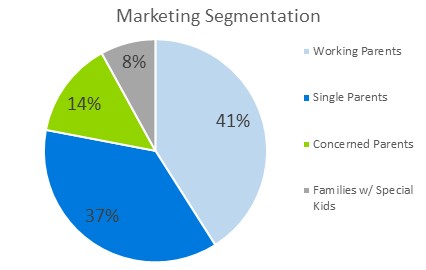
Business Plan for Investors
5.2.1 Working Parents
Our main customers will be working parents living in and around Florida. These parents usually have eight-hour jobs that keep them busy. Therefore, they are expected to utilize our services most often. We will offer them a place where they can leave their children without any worry. At us, they will have a space where their kids can play and learn new things and skills.
5.2.2 Single Parents
Our second target customer will be the single parents who need as much help as they can get. Single parents usually have to manage everything on their own. Therefore, a service of this sort will be of great help to them. By entrusting their kids to us, they will be able to do daily chores and relax for a while.
5.2.3 Concerned Parents
A lot of parents usually get concerned that their children are not learning as fast as they could. For these parents, our educational services will be the most attractive. We will offer learning sessions in several niches so that parents can choose what they want their kids to learn.
5.2.4 Families with Special Care Kids
Lastly, LearnALot will cater to those children as well who don’t learn at the same pace as other students. Parents can bring their children to get assessed and our preschool will try its best to cater to the children in the most helpful way.
| Market Analysis | |||||||
| Potential Customers | Growth | Year 1 | Year 2 | Year 3 | Year 4 | Year 5 | CAGR |
| Working Parents | 41% | 55,100 | 66,120 | 79,344 | 95,213 | 114,255 | 10.00% |
| Single Parents | 37% | 45,100 | 54,120 | 64,944 | 77,933 | 93,519 | 10.00% |
| Concerned Parents | 14% | 25,100 | 30,120 | 36,144 | 43,373 | 52,047 | 10.00% |
| Families w/ Special Kids | 8% | 25,100 | 30,120 | 36,144 | 43,373 | 52,047 | 11.00% |
| Total | 100% | 150,400 | 180,480 | 216,576 | 259,891 | 311,869 | 10% |
5.3 Business Target
The target of LearnALot is:
- To become a safe and reliable place where parents can drop off their children regularly.
- To become the best preschool/ daycare center in Florida.
- To expand the range of services we offer.
- To earn a profit margin of $10k/month after the first two years to sustain the business.
5.4 Product Pricing
Our prices for specialized cleaning are a little higher than those of our competitors. However, our other offerings are available to our customers in a similar price range as that of our competitors.
Marketing Strategy
To develop a preschool marketing plan template that will help you succeed, you will need to develop strategies that will work for your market. A good marketing plan is a part of every business plan. Therefore, you will need it for your daycare and preschool business plan as well. In this business plan for preschool pdf, we are providing the preschool business plan sample for LearnALot.
If you are also offering physical training and game sessions, you can also see the marketing strategy for karate center business plan.
6.1 Competitive Analysis
- We have versatile offers and services to cater to parents who want to drop off their kids for different periods.
- Our customers can directly contact us in case they need any special services.
- We are offering pick and drop service to facilitate the parents even more.
6.2 Sales Strategy
- We will advertise through local news channels, posters, and social media posts.
- We will offer discounted rates to the first 15 customers.
- We will offer different types of affordable packages to parents so that using a preschool doesn’t break their bank.
6.3 Sales Monthly
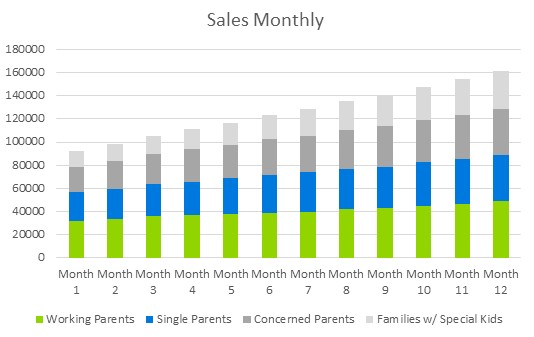
6.4 Sales Yearly

6.5 Sales Forecast
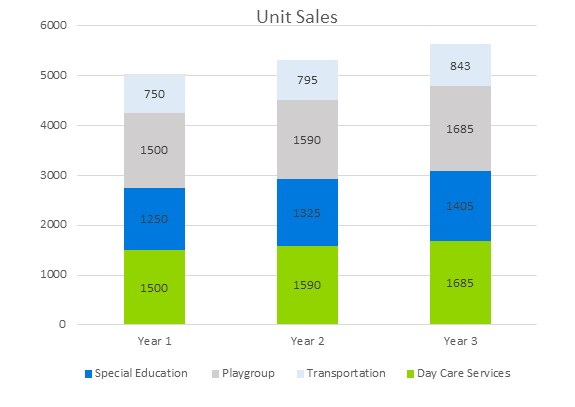
| Sales Forecast | |||
| Unit Sales | Year 1 | Year 2 | Year 3 |
| Day Care Services | 1,500 | 1,590 | 1,685 |
| Special Education | 1,250 | 1,325 | 1,405 |
| Playgroup | 1,500 | 1,590 | 1,685 |
| Transportation | 750 | 795 | 843 |
| TOTAL UNIT SALES | 5,000 | 5,300 | 5,618 |
| Unit Prices | Year 1 | Year 2 | Year 3 |
| Day Care Services | $250.00 | $290.00 | $336.40 |
| Special Education | $150.00 | $174.00 | $201.84 |
| Playgroup | $250.00 | $290.00 | $336.40 |
| Transportation | $200.00 | $232.00 | $269.12 |
| Sales | |||
| Day Care Services | $375,000.00 | $461,100.00 | $566,968.56 |
| Special Education | $187,500.00 | $230,550.00 | $283,484.28 |
| Playgroup | $375,000.00 | $461,100.00 | $566,968.56 |
| Transportation | $150,000.00 | $184,440.00 | $226,787.42 |
| TOTAL SALES | $1,087,500.00 | $1,337,190.00 | $1,644,208.82 |
| Direct Unit Costs | Year 1 | Year 2 | Year 3 |
| Day Care Services | $75.00 | $82.50 | $86.63 |
| Special Education | $60.00 | $66.00 | $69.30 |
| Playgroup | $85.00 | $93.50 | $98.18 |
| Transportation | $70.00 | $77.00 | $80.85 |
| Direct Cost of Sales | |||
| Day Care Services | $112,500.00 | $131,175.00 | $145,997.78 |
| Special Education | $75,000.00 | $87,450.00 | $97,331.85 |
| Playgroup | $127,500.00 | $148,665.00 | $165,464.15 |
| Transportation | $52,500.00 | $61,215.00 | $68,132.30 |
| Subtotal Direct Cost of Sales | $367,500.00 | $428,505.00 | $476,926.07 |
Personnel plan
A business plan preschool like any other business includes the strategy to hire the employees for your business. To get an idea of how many employees you may need, you may consult a business plan for language school sample. In this preschool business plan pdf we are providing the employee list made by Theo to run the preschool.
7.1 Company Staff
- 1 Manager
- 5 Trained Teachers
- 2 Cleaners
- 1 Sales Executive
- 1 Guard
7.2 Average Salary of Employees
| Personnel Plan | |||
| Year 1 | Year 2 | Year 3 | |
| Manager | $30,000 | $33,000 | $36,300 |
| Trained Teachers | $175,000 | $192,500 | $211,750 |
| Cleaners | $45,000 | $49,500 | $54,450 |
| Sales Executive | $22,500 | $24,750 | $27,225 |
| Guard | $22,500 | $24,750 | $27,225 |
| Total Salaries | $295,000 | $324,500 | $356,950 |
Financial Plan
When you look at preschool business plan examples, you will notice that all of them outline their finances in one way or another. Financial information is always a part of every preschool business plan sample pdf. Accurate financial planning enables you to fund your business, and earn revenue.
Due to the immense importance of financial planning in a business, it is advisable to not experiment with developing a financial plan. Financial planning is of utmost importance and it impacts the sustainability of a business in the long term. Keeping it in mind, you should hire a professional financial planning expert for the task. Various business frims would do the task for you even online.
Below, we are providing the financial analysis for LearnALot. You can follow this template to do financial analysis for your martial arts business plan as well.
8.1 Important Assumptions
| General Assumptions | |||
| Year 1 | Year 2 | Year 3 | |
| Plan Month | 1 | 2 | 3 |
| Current Interest Rate | 8.12% | 8.20% | 8.26% |
| Long-term Interest Rate | 8.40% | 8.44% | 8.47% |
| Tax Rate | 24.03% | 24.21% | 24.60% |
| Other | 0 | 0 | 0 |
8.2 Break-even Analysis
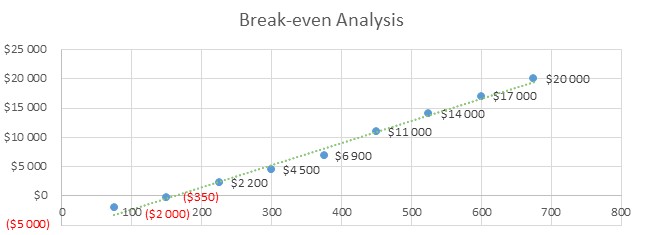
| Break-Even Analysis | |
| Monthly Units Break-even | 5340 |
| Monthly Revenue Break-even | $132,500 |
| Assumptions: | |
| Average Per-Unit Revenue | $231.00 |
| Average Per-Unit Variable Cost | $0.62 |
| Estimated Monthly Fixed Cost | $163,800 |
8.3 Projected Profit and Loss
| Pro Forma Profit And Loss | |||
| Year 1 | Year 2 | Year 3 | |
| Sales | $1,087,500 | $1,337,190 | $1,644,209 |
| Direct Cost of Sales | $367,500 | $428,505 | $476,926 |
| Other | $0 | $0 | $0 |
| TOTAL COST OF SALES | $367,500 | $428,505 | $476,926 |
| Gross Margin | $720,000 | $908,685 | $1,167,283 |
| Gross Margin % | 66.21% | 67.95% | 70.99% |
| Expenses | |||
| Payroll | $295,000 | $324,500 | $356,950 |
| Sales and Marketing and Other Expenses | $145,000 | $148,000 | $156,000 |
| Depreciation | $2,300 | $2,350 | $2,500 |
| Leased Equipment | $0 | $0 | $0 |
| Utilities | $2,900 | $3,000 | $3,100 |
| Insurance | $2,100 | $2,100 | $2,100 |
| Rent | $2,900 | $3,000 | $3,200 |
| Payroll Taxes | $24,000 | $25,000 | $27,000 |
| Other | $0 | $0 | $0 |
| Total Operating Expenses | $474,200 | $507,950 | $550,850 |
| Profit Before Interest and Taxes | $245,800 | $400,735 | $616,433 |
| EBITDA | $245,800 | $400,735 | $616,433 |
| Interest Expense | $0 | $0 | $0 |
| Taxes Incurred | $49,160 | $80,147 | $123,287 |
| Net Profit | $196,640 | $320,588 | $493,146 |
| Net Profit/Sales | 18.08% | 23.97% | 29.99% |
8.3.1 Profit Monthly
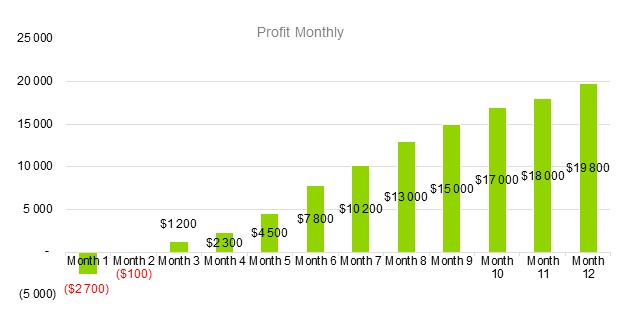
8.3.2 Profit Yearly
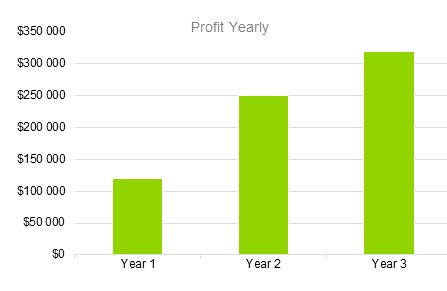
8.3.3 Gross Margin Monthly
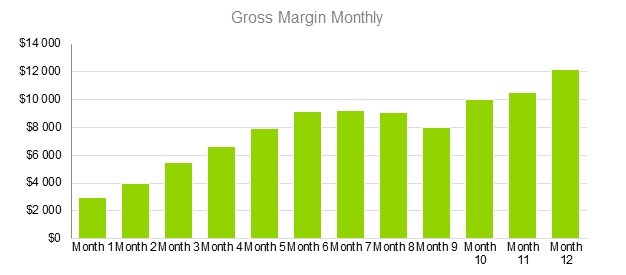
8.3.4 Gross Margin Yearly
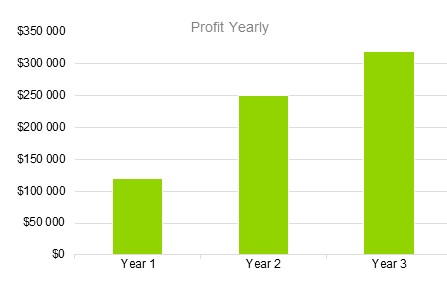
8.4 Projected Cash Flow
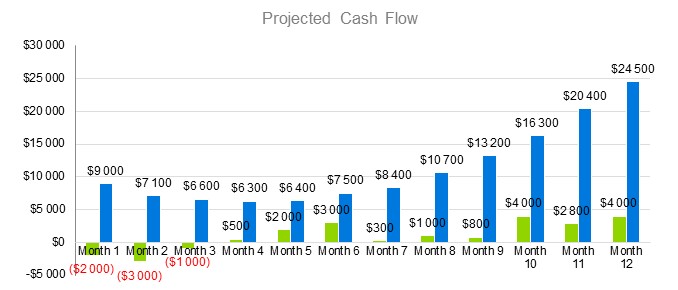
| Pro Forma Cash Flow | |||
| Cash Received | Year 1 | Year 2 | Year 3 |
| Cash from Operations | |||
| Cash Sales | $51,000 | $55,080 | $59,486 |
| Cash from Receivables | $22,000 | $23,760 | $25,661 |
| SUBTOTAL CASH FROM OPERATIONS | $73,000 | $79,570 | $85,936 |
| Additional Cash Received | |||
| Sales Tax, VAT, HST/GST Received | $0 | $0 | $0 |
| New Current Borrowing | $0 | $0 | $0 |
| New Other Liabilities (interest-free) | $0 | $0 | $0 |
| New Long-term Liabilities | $0 | $0 | $0 |
| Sales of Other Current Assets | $0 | $0 | $0 |
| Sales of Long-term Assets | $0 | $0 | $0 |
| New Investment Received | $0 | $0 | $0 |
| SUBTOTAL CASH RECEIVED | $74,000 | $79,000 | $85,000 |
| Expenditures | Year 1 | Year 2 | Year 3 |
| Expenditures from Operations | |||
| Cash Spending | $42,000 | $42,000 | $45,000 |
| Bill Payments | $27,000 | $28,000 | $31,000 |
| SUBTOTAL SPENT ON OPERATIONS | $69,000 | $70,000 | $76,000 |
| Additional Cash Spent | |||
| Sales Tax, VAT, HST/GST Paid Out | $0 | $0 | $0 |
| Principal Repayment of Current Borrowing | $0 | $0 | $0 |
| Other Liabilities Principal Repayment | $0 | $0 | $0 |
| Long-term Liabilities Principal Repayment | $0 | $0 | $0 |
| Purchase Other Current Assets | $0 | $0 | $0 |
| Purchase Long-term Assets | $0 | $0 | $0 |
| Dividends | $0 | $0 | $0 |
| SUBTOTAL CASH SPENT | $69,000 | $74,520 | $80,482 |
| Net Cash Flow | $21,000 | $23,000 | $25,000 |
| Cash Balance | $27,000 | $30,000 | $33,000 |
8.5 Projected Balance Sheet
| Pro Forma Balance Sheet | |||
| Assets | Year 1 | Year 2 | Year 3 |
| Current Assets | |||
| Cash | $275,000 | $308,000 | $338,800 |
| Accounts Receivable | $24,000 | $26,880 | $30,213 |
| Inventory | $4,300 | $4,816 | $4,900 |
| Other Current Assets | $1,000 | $1,000 | $1,000 |
| TOTAL CURRENT ASSETS | $282,000 | $315,840 | $355,004 |
| Long-term Assets | |||
| Long-term Assets | $10,000 | $10,000 | $10,000 |
| Accumulated Depreciation | $19,400 | $21,728 | $24,444 |
| TOTAL LONG-TERM ASSETS | $24,400 | $27,328 | $30,744 |
| TOTAL ASSETS | $294,000 | $329,280 | $370,440 |
| Liabilities and Capital | Year 4 | Year 5 | Year 6 |
| Current Liabilities | |||
| Accounts Payable | $18,700 | $20,944 | $23,541 |
| Current Borrowing | $0 | $0 | $0 |
| Other Current Liabilities | $0 | $0 | $0 |
| SUBTOTAL CURRENT LIABILITIES | $19,000 | $21,280 | $23,919 |
| Long-term Liabilities | $0 | $0 | $0 |
| TOTAL LIABILITIES | $15,000 | $16,800 | $18,883 |
| Paid-in Capital | $30,000 | $30,000 | $31,000 |
| Retained Earnings | $53,000 | $57,770 | $63,547 |
| Earnings | $193,400 | $210,806 | $231,887 |
| TOTAL CAPITAL | $285,000 | $310,650 | $341,715 |
| TOTAL LIABILITIES AND CAPITAL | $300,000 | $329,280 | $370,440 |
| Net Worth | $293,400 | $319,806 | $351,787 |
8.6 Business Ratios
| Ratio Analysis | ||||
| Year 1 | Year 2 | Year 3 | INDUSTRY PROFILE | |
| Sales Growth | 7.25% | 8.03% | 8.90% | 3.00% |
| Percent of Total Assets | ||||
| Accounts Receivable | 9.21% | 10.20% | 11.31% | 9.80% |
| Inventory | 5.39% | 5.97% | 6.62% | 9.90% |
| Other Current Assets | 2.11% | 2.34% | 2.59% | 2.40% |
| Total Current Assets | 149.80% | 151.00% | 152.00% | 158.00% |
| Long-term Assets | 11.55% | 11.60% | 11.64% | 12.00% |
| TOTAL ASSETS | 100.00% | 100.00% | 100.00% | 100.00% |
| Current Liabilities | 4.90% | 4.94% | 4.98% | 4.34% |
| Long-term Liabilities | 0.00% | 0.00% | 0.00% | 0.00% |
| Total Liabilities | 7.59% | 7.65% | 7.72% | 7.38% |
| NET WORTH | 100.45% | 101.25% | 102.19% | 110.00% |
| Percent of Sales | ||||
| Sales | 100.00% | 100.00% | 100.00% | 100.00% |
| Gross Margin | 94.60% | 97.15% | 99.87% | 99.00% |
| Selling, General & Administrative Expenses | 93.56% | 96.09% | 98.78% | 97.80% |
| Advertising Expenses | 1.52% | 1.56% | 1.60% | 1.40% |
| Profit Before Interest and Taxes | 41.50% | 42.62% | 43.81% | 33.90% |
| Main Ratios | ||||
| Current | 34 | 35 | 36 | 32 |
| Quick | 33 | 33.8 | 34.645 | 33 |
| Total Debt to Total Assets | 0.18% | 0.18% | 0.17% | 0.40% |
| Pre-tax Return on Net Worth | 74.08% | 74.89% | 75.00% | 75.00% |
| Pre-tax Return on Assets | 96.30% | 101.12% | 106.17% | 111.30% |
| Additional Ratios | Year 1 | Year 2 | Year 3 | |
| Net Profit Margin | 33.56% | 34.60% | 35.67% | N.A. |
| Return on Equity | 55.80% | 57.53% | 59.31% | N.A. |
| Activity Ratios | ||||
| Accounts Receivable Turnover | 7.7 | 7.8 | 7.8 | N.A. |
| Collection Days | 100 | 100 | 100 | N.A. |
| Inventory Turnover | 32.4 | 34.02 | 35 | N.A. |
| Accounts Payable Turnover | 15.6 | 16 | 16.3 | N.A. |
| Payment Days | 27 | 27 | 27 | N.A. |
| Total Asset Turnover | 2.5 | 2.5 | 2.6 | N.A. |
| Debt Ratios | ||||
| Debt to Net Worth | -0.04 | -0.03 | -0.04 | N.A. |
| Current Liab. to Liab. | 1 | 1 | 1 | N.A. |
| Liquidity Ratios | ||||
| Net Working Capital | $244,000 | $257,664 | $272,093 | N.A. |
| Interest Coverage | 0 | 0 | 0 | N.A. |
| Additional Ratios | ||||
| Assets to Sales | 0.85 | 0.87 | 0.89 | N.A. |
| Current Debt/Total Assets | 1% | 0% | 0% | N.A. |
| Acid Test | 29 | 29.12 | 29.16 | N.A. |
| Sales/Net Worth | 2.1 | 2.2 | 2.2 | N.A. |
| Dividend Payout | 0 | 0 | 0 | N.A. |
FAQs
- Are preschoolers profitable?
Opening a preschool business can prove profitable if you do a financial analysis to make sure that the cash flows are managed well.
- How can I grow my preschool business?
You can grow your preschool business by reading preschool business plans for preschools that are running successfully.
- What are the steps to start a preschool?
The first step is to make starting up a preschool business plan and then deal with every aspect of your business including the finances, marketing, and services you will offer.
- How do you write a preschool proposal?
You can write a business plan for the preschool center by following the template provided above.




 (9 votes, average: 4.33 out of 5)
(9 votes, average: 4.33 out of 5)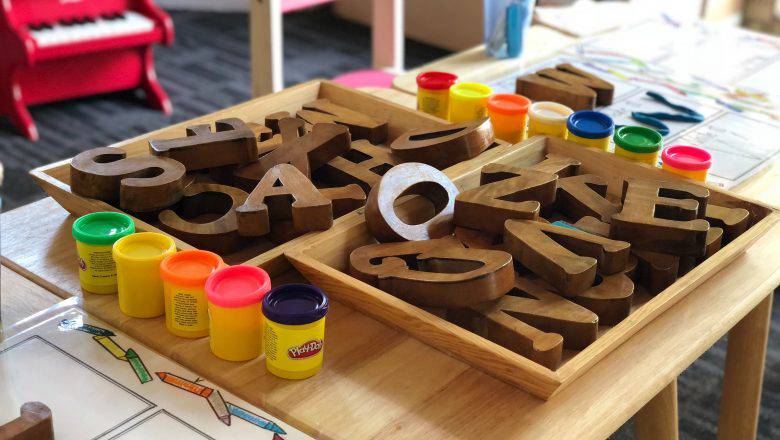





Add comment
Comments (0)